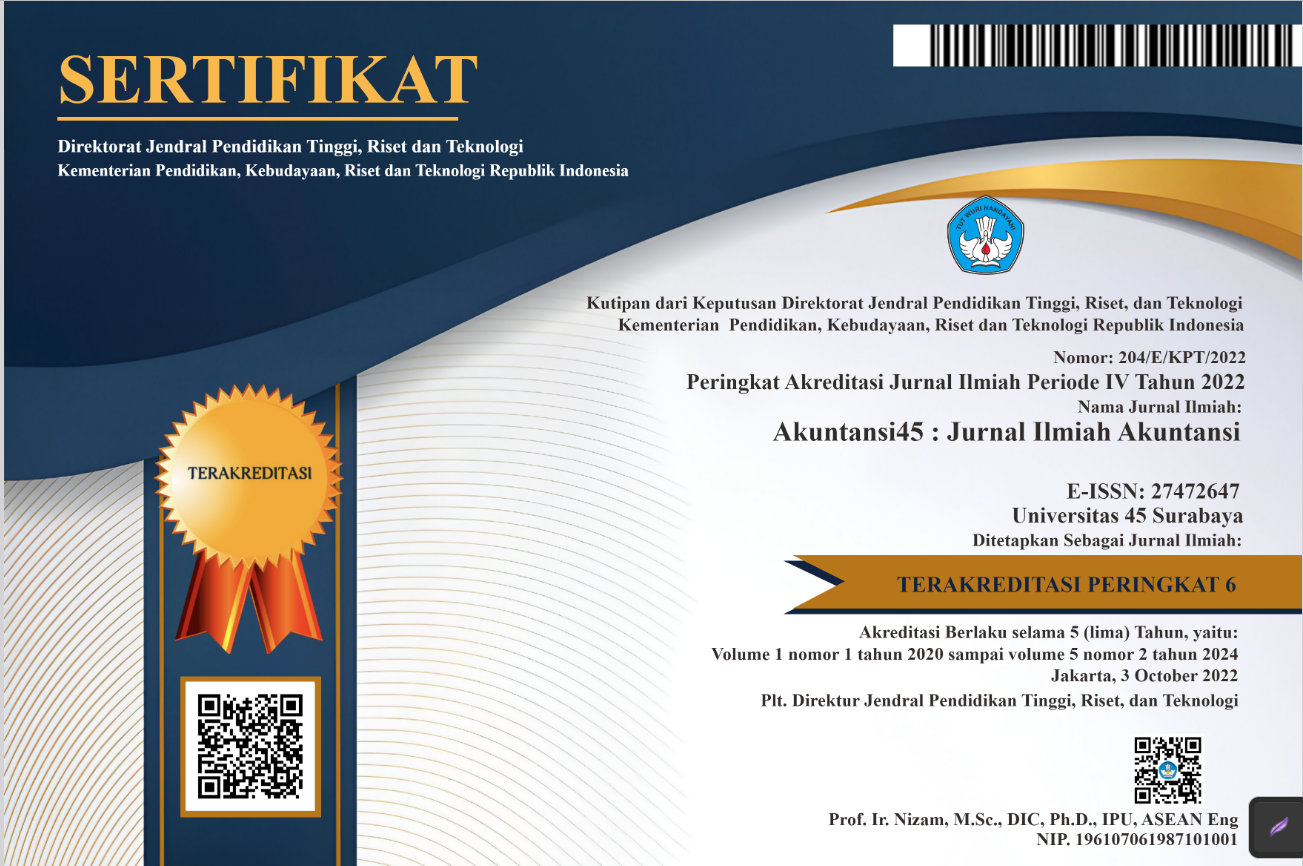Pengaplikasian Metode Autoregressive Distributed Lag Dalam Analisis Pengaruh Inflasi Pertumbuhan Ekonomi Dan FDI Terhadap Pengangguran Di Indonesia
DOI:
https://doi.org/10.30640/akuntansi45.v4i2.1849Keywords:
unemployment, inflation, economic growth, foreign direct investmentAbstract
This study aims to examine the impact of inflation, economic growth, and foreign investment on unemployment rates in Indonesia. The analysis method used is autoregressive distributed lag (ARDL) using time series data from 1991 to 2018 obtained from the World Development Indicators of the World Bank. The research findings indicate that inflation has a significant negative impact in the short term but is not significant in the long term in Indonesia. Economic growth has a significant negative impact on unemployment rates both in the short and long term, while foreign investment also has a significant negative impact on unemployment rates in both the short and long term in Indonesia. Through the ARDL model, this study provides evidence that inflation, economic growth, foreign investment, and unemployment are co-integrated in the long run or move together in the long term. These four variables also exhibit dynamic relationships in the short term, indicating a relatively high speed of adjustment towards equilibrium each year. Based on the research findings, it is recommended that policymakers, particualry the government, create a conducive investment environment by reducing structural barriers in the economy to attract domestic and foreign investments, which, in turn, will stimulate economic growth and create job opportunities in Indonelsia.
References
Adarkwa, S. (2017). The Impact of Economic Growth on Unemployment in Ghana: Which Economic Sector Matters Most? The International Journal of Business & Management, 2321–8916. Retrieved from www.theijbm.com
Ajie, H. A., Ani, E. C., & Ameh, O. E. (2017). An Examination of the Impact of Unemployment and Inflation on The Nigerian Economy : A Bounds Testing Approach. Journal of Public Policy and Administration, 1(1), 22–34. https://doi.org/10.11648/j.jppa.20170101.13
Al-Habees, M. A., & Rumman, M. A. (2012). The Relationship between Unemployment and Economic Growth in Jordan and Some Arab Countries. World Applied Sciences Journal, 18(5), 673–680. https://doi.org/10.5829/idosi.wasj.2012.18.05.16712
Alisa, M. (2015). The Relationship between Inflation and Unemployment: A Theoretical Discussion about the Philips Curve. Journal of International Business and Economics, 3(2), 89–97. https://doi.org/10.15640/jibe.v3n2a7
Amor, M. Ben, & Hassine, M. Ben. (2017). The Relationship between Unemployment and Economic Growth: Is Okun’s Law Valid for The Saudi Arabia Case? International Journal of Economics and Business Research, 14(1), 44–60. https://doi.org/10.1504/IJEBR.2017.085553
Barens, I. (2011). To Use The Words of Keynes...": Olivier J. Blanchard on Keynes and The "Liquidity Trap. Darmstadt Discussion Papers in Economics.
Behera, J., & Mishra, A. K. (2017). The Recent Inflation Crisis and Long-run Economic Growth in India: An Empirical Survey of Threshold Level of Inflation. South Asian Journal of Macroeconomics and Public Finance, 6(1), 105–132. https://doi.org/10.1177/2277978717695154
Bhattarai, K. (2016). Unemployment-Inflation Trade-Offs in OECD Countries. Economic Modelling, 58, 93–103. https://doi.org/10.1016/j.econmod.2016.05.007
Brozen, Y. (1958). Means for Maintaining Economic Stability. Journal of Farm Economics, 40(5), 1069. https://doi.org/10.2307/1234973
Davidson, C., & Matusz, S. J. (2004). International Trade and Labor Markets: Theory, Evidence, and Policy Implications. In International Trade and Labor Markets: Theory, Evidence, and Policy Implications. https://doi.org/10.17848/9781417505920
Davidson, P. (1998). Post Keynesian Employment Analysis And The Macroeconomics Of Oecd Unemployment 1. The Post Keynesian Explanation of OECD Unemployment. The Economic Journal, 108, 817–831.
Djambaska, E., & Lozanoska, A. (2015). Foreign Direct Investment and Unemployment Evidence From The Republic of Macedonia. International Journal of Economics, Commerce and Management United Kingdom, III(12), 73–85. https://doi.org/10.1111/j.1467- 9701.2010.01324.x
Dutt, P., Mitra, D., & Ranjan, P. (2009). International trade and unemployment: Theory and cross- national evidence. Journal of International Economics, 78(1), 32–44. https://doi.org/10.1016/j.jinteco.2009.02.005
Hanusch, M. (2013). Jobless Growth? Okun’S Law in East Asia. Journal of International Commerce, Economics and Policy, 4(03), 1350014. https://doi.org/10.1142/s1793993313500142
Idenyi, O., Favour, E.-O., Johnson, N., & Thomas, O. (2017). Understanding the Relationship between Unemployment and Inflation in Nigeria. Advances in Research, 9(2), 1–12. https://doi.org/10.9734/air/2017/32218
ILO. (2019). Quick Guide on Interpreting The Unemployment. International Labour Organization.
Irpan, H. M., Saad, R. M., Nor, A. H. S. M., Noor. A. H. M., & Ibrahim, N. (2016). Impact of Foreign Direct Investment on The Unemployment Rate in Malaysia. Journal of Physics: Conference Series, 710(1). https://doi.org/10.1088/1742-6596/710/1/012028
Johnny, N., Timipere, E. T., & Krokeme, O. (2018). Impact of Foreign Direct Investment on Unemployment Rate in Nigeria (1980-2015). International Journal of Academic Research in Business and Social Sciences, 8(3). https://doi.org/10.6007/ijarbss/v8-i3/3905
Kasseh, P. A. (2018). The Relation between Inflation and Unemployment in the Gambia: Analysis of the Philips Curve. Journal of Global Economics, 6(02), 6–12. https://doi.org/10.4172/2375-4389.1000294
Keynes, J. M. (1936). The General Theory of Employment, Interest and Money. London: Harcourt., 31(196), 791. https://doi.org/10.2307/2278703
Kunle, A., S.O., O., & Oluwafolakemi, F. O. (2014). Impact of Foreign Direct Investment on Nigeria Economic Growth. International Journal of Academic Research in Business and Social Sciences, 4(8), 234–242. https://doi.org/10.6007/ijarbss/v4-i8/1092
Kurtovic, S., Siljkovic, B., & Milanovic, M. (2015). Long-Term Impact of Foreign Direct Investment on Reduction of Unemployment : Panel Data Analysis of The Western Balkans Countries. Journal of Applied Economics and Business Research, 5(2), 112–129.
Mitra, D., & Ranjan, P. (2010). Offshoring and Unemployment: The Role of Search Frictions Labor Mobility. Journal of International Economics, 81(2), 219–229. https://doi.org/10.1016/j.jinteco.2010.04.001
Moore, M. P., & Ranjan, P. (2005). Globalisation vs Skil-Biased Technological Change: Implications for Unemployment and Wage Inequality. Economic Journal, 115(503), 391– 422. https://doi.org/10.1111/j.1468-0297.2005.00994.x
Nikolli, EL. (2014). Economic Growth and Unemployment Rate. Case of Albania. European Journal of Social Sciences Education and Research, 1(1), 217. https://doi.org/10.26417/ejser.v1i1.p217-227
Okun, AL. M. (1962). Potential GNP: Its Measurement and Significance, Cowles Foundation Paper
Cowles Foundation, Yale University: New Haven, CT, USA.
Orji, A., Orji, O. A., & Okafor, J. C. (2015). Inflation and Unemployment Nexus in Nigeria: Another Test of the Philips Curve. Asian Economic and Financial Review, 5(5), 766–778. https://doi.org/10.18488/journal.aefr/2015.5.5/102.5.766.778
Parker, J. (2010). Models of Unemployment. Economics 314 Coursebook, (40), 86–87.
Phillips, A. W. (1958). The Relation between Unemployment and The Rate of Change of Money Wage Rates in the United Kingdom, 1861-1957. Economica, 25(100), 283. https://doi.org/10.2307/2550759
Pigou, AL. C. (1934). Theory of Unemployment. Analysis (United Kingdom), 31(6), 177–186. https://doi.org/10.1093/analys/31.6.177
Pinn, S. L. S., Ching, K. S., Kogid, M., Mulok, D., Mansur, K., & Loganathan, N. (2011). Empirical Analysis of Employment and Foreign Direct Investment in Malaysia: An ARDL Bounds Testing Approach to Cointegration. Advances in Management and Applied Economics, 1(3), 77–91.
Quy, N. H. (2016). Rellaltionship beltweleln ELconomic Growth, Unelmploymelnt alnd Povelrty: ALnallysis alt Provinciall Lelvell in Vietnam. Internationa Journal of Economics and Finance, 8(12), 113. https://doi.org/10.5539/ijef.v8n12p113
Seth, A., John, M. A., & Dalhatu, A. Y. (2018). The Impact of Unemployment on Economic Growth in Nigeria: An Application of Autoregressive Distributed Lag (ARDL) Bound Testing. Sumerianz Journal of Business Management and Marketing, 1(2), 37–46. https://doi.org/10.9790/0837-2211077481
Singh, D., & Verma, N. (2016). Tradeoff between Inflation and Unemployment in The Short Run: A Case of the Indian Economy. International Finance and Banking, 3(1), 77. https://doi.org/10.5296/ifb.v3i1.9378
Stamatiou, P., & Dritsakis, N. (2014). The Impact of Foreign Direct Investment on the Unemployment Rate and Economic Growth in Greece: A Time Series Analysis. International Work-Conference on Time Series Analysis (ITISE), 8(10), 4900–4906.
Strat, V. A., Davidescu, A., & Paul, A. M. (2015). FDI and The Unemployment-A Causality Analysis for the Latest EU Members. Procedia Economics and Finance, 23, 635–643. https://doi.org/10.1016/s2212-5671(15)00448-7
Tegep, J., Suratman, E., & Indra, S. (2019). The Failure of Foreign Direct Investment to Explain Unemployment Rate and The Mediating Role of Economic Growth and Minimum Wage. International Journal of Economics and Financial Issues, 9(2), 154–161.
Tenzin, U. (2019). The Nexus Among Economic Growth, Inflation and Unemployment in Bhutan.
South Asia Economic Journal, 20(1), 94–105. https://doi.org/10.1177/1391561418822204
Wulandari, D., Utomo, S. H., Narmaditya, B. S., & Kamaludin, M. (2019). Nexus between Inflation and Unemployment: Evidence from Indonesia. Journal of Asian Finance, Economics and Business, 6(2), 269–275. https://doi.org/10.13106/jafeb.2019.vol6.no2.269
Yolanda, Y. (2017). Analysis of Factors Affecting Inflation and Its Impact on Human Development Index and Poverty in Indonesia. European Research Studies Journal, 20(4), 38–56. https://doi.org/10.35808/ersj/873
Zeb, N., Qiang, F., & Sharif, M. S. (2014). Foreign Direct Investment and Unemployment Reduction in Pakistan. International Journal of Economics and Research, 10–17.









